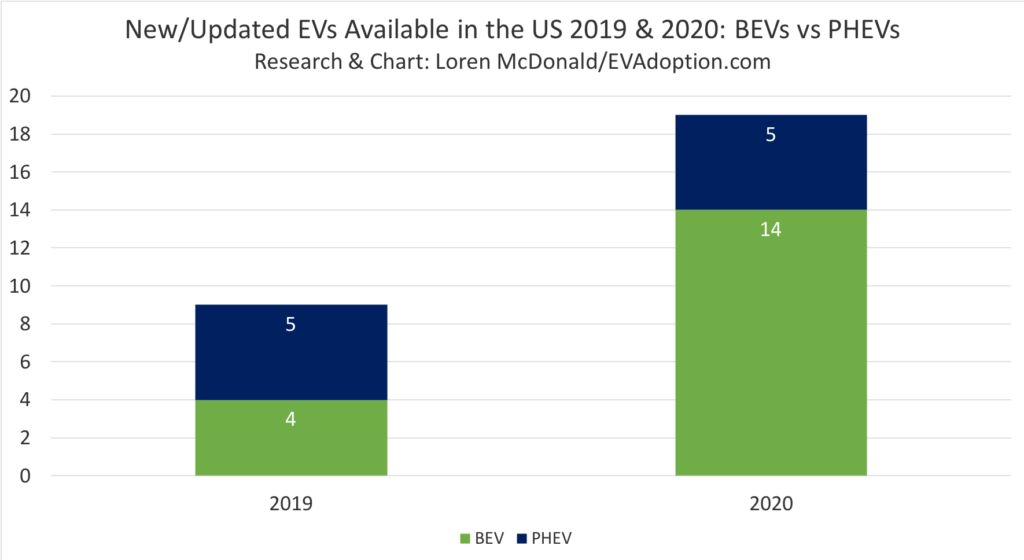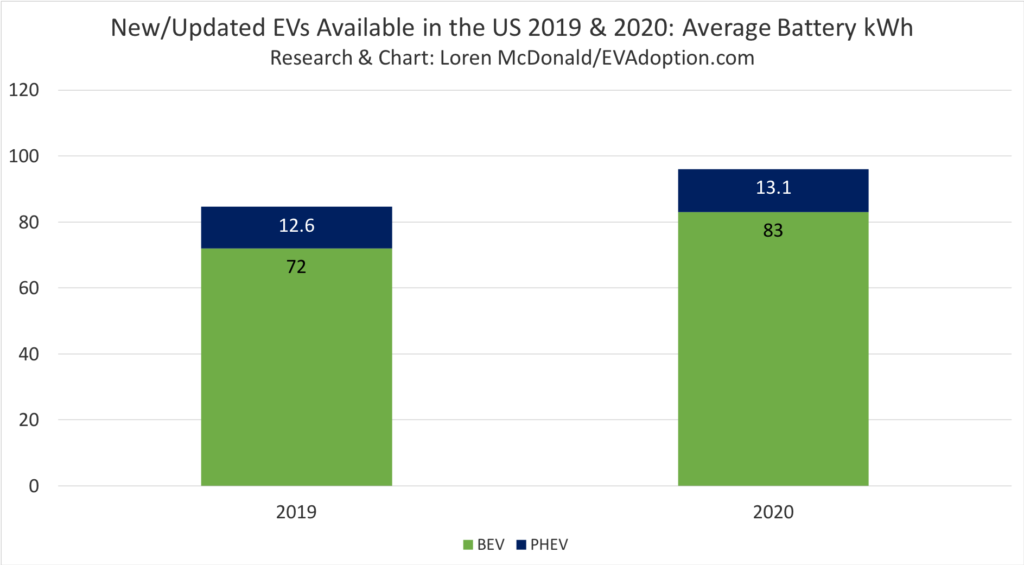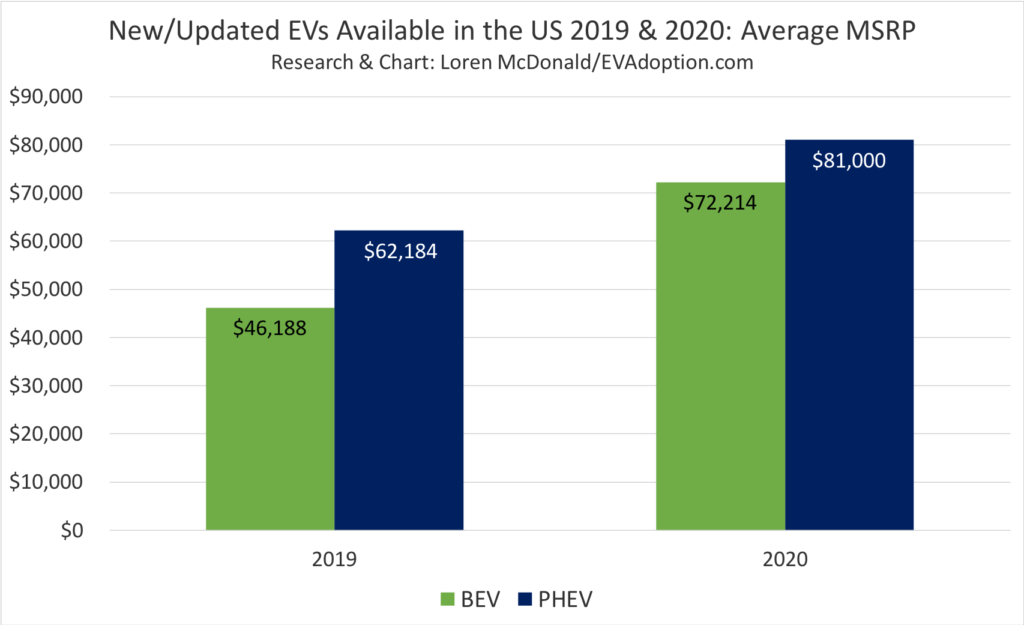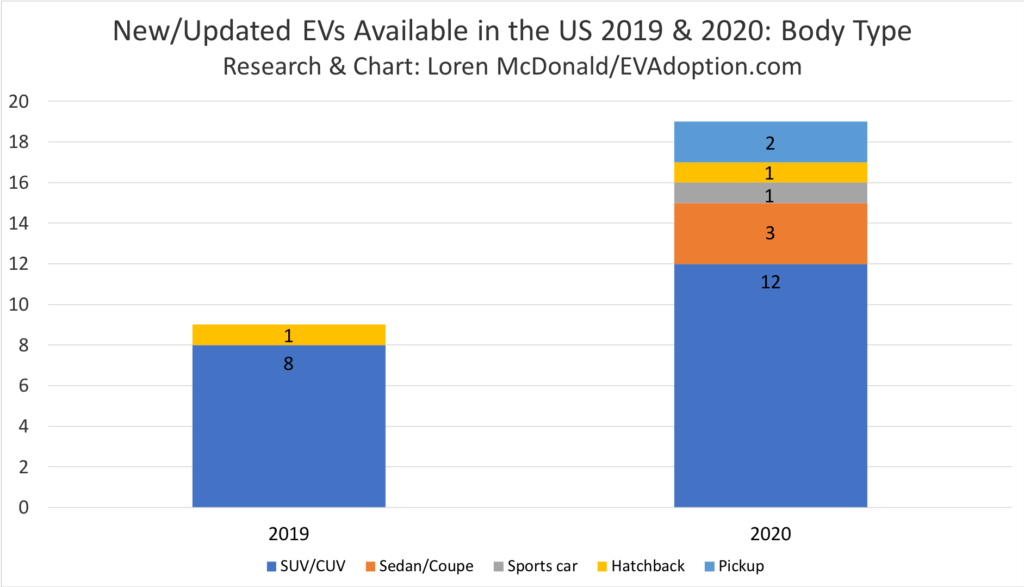[DISPLAY_ULTIMATE_SOCIAL_ICONS]
During 2019 to 2020 we expect an estimated 26 new electric vehicles (both BEV and PHEV) will be available in the United States, according to new EVAdoption analysis. Including existing BEVs that will have significant battery pack and range increases (Nissan LEAF, Kia Soul), this number rises to 28. (View slide presentations of all models at the end of this article.)
At the end of 2018 43 BEVs and PHEVs were available in the US, though 3 EVs – the Ford Focus EV, Mercedes-Benz B250e and Cadillac CT6 PHEV – were discontinued and were only seeing sales of a few units per month of remaining inventory. Only two new electric vehicles came to market in 2018, the Jaguar I-Pace and Mercedes-Benz GLC 350c PHEV, versus the expected 9 and 19 in 2019 and 2020 respectively.
Tracking the number of expected new EVs is obviously key to forecasting future sales of EVs in the US, but fundamentally the number and type of new available EVs are critical to driving growth and adoption of electric vehicles. Our analysis from 2018 (New EV Models Responsible For Nearly All Annual US EV Sales Growth – New Analysis) uncovered that the vast majority of growth in EV sales each year has come from the introduction of new EVs during the year or late the previous year.
For the last two years we’ve been tracking future electric vehicles that have been announced or rumored to be available in the US in the next few years. In some cases availability timelines and select specifications have been announced or highly speculated and in other situations we have used our best guesses and insights based on similar models.
With that in mind, we decided to focus on the near term – 2019 and 2020 – and have analyzed trends in 5 charts covering: number of EVs expected/ powertrain type (BEV vs. PHEV), range, battery pack size, MSRP, and body type.
5 Charts Analyzing New Future EVs Available in the US: 2019-2020
In 2019, 4 of the EVs are BEVs and 5 PHEVs versus 14 BEVs and 5 PHEVs expected in 2020.

The average estimated EPA range of new PHEVs is 28.2 miles in 2019 and 27.2 miles in 2020. The average range of new BEVs in 2019 is 231.5 and 242.7 in 2020.

Average battery pack size is 12.6 kWh for new PHEVs in 2019 and 13.1 kWH in 2020. BEV battery pack size averages 72 kWh in 2019 and 83 kWh in 2020.

The average manufacturer’s suggested retail price (MSRP) for PHEVs in 2019 is $62,184 and $46,188 for BEVs. (Note: We’ve used the expected base price for each model, but when multiple battery pack options will be available such as for the Rivian RT1, we’ve used estimated MSRP for the largest battery pack.)
For 2020, PHEVs increase to $81,000 mostly because of the Bentley Bentayga PHEV ($190,000) and Maserati Levante PHEV ($90,000). Average MSRP for BEVs increases to $72,214 in 2020 mostly from the estimated $250,000 price tag on the Aston Martin RapedE.

Among body types, SUVs and CUVs dominate in 2019 with 8 EV models and one hatchback (the longer range Nissan LEAF). Body style options will be much broader in 2020, with 12 being SUVs/CUVs; 3 categorized as sedans/coupes, sports activity coupes and sportsbacks; 2 pickups/trucks; one hatchback; and one sports car.

Across both years, the following brands are introducing the most new and/or significantly updated EVs:
- Kia: 3 (Niro EV, Stonic, Soul – updated)
- Audi: 2 (e-tron, e-tron Sportsback)
- BMW: 2 (iX3, X5)
- Ford: 2 (Escape PHEV, Unnamed BEV SUV/CUV)
- Land Rover: 2 (Range Rover P400e, Range Rover Sport)
Slide Presentations of Future EVs for 2019 and 2020
Check out below our new slide presentation of all 9 EVs introduced (or expected) in 2019, including a photo, estimated MSRP, EPA range and battery pack size.
Check out below our new slide presentation of all 19 EVs expected in 2020, including a photo, estimated MSRP, EPA range, and battery pack size.



2 Responses
Why I do not see anything about Volvo T8’s Plug In Hybrids here?
The Volvo PHEVs are already available and listed here – https://evadoption.com/ev-models/ – the above slides are for new EVs coming to market, or in the case of the Kia Soul and Nissan LEAF, ones with significant batter upgrades.